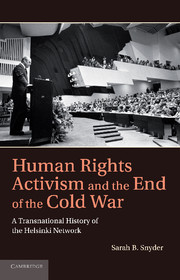Book contents
- Frontmatter
- Contents
- Acknowledgments
- Introduction
- 1 Bridging the East–West Divide
- 2 “A Sort of Lifeline”
- 3 Even in a Yakutian Village
- 4 Follow-up at Belgrade
- 5 Helsinki Watch, the IHF, and the Transnational Campaign for Human Rights in Eastern Europe
- 6 Human Rights in East–West Diplomacy
- 7 “A Debate in the Fox Den About Raising Chickens”
- 8 “Perhaps Without You, Our Revolution Would Not Be”
- Conclusion
- Bibliography
- Index
4 - Follow-up at Belgrade
The United States Transforms the Helsinki Process
Published online by Cambridge University Press: 01 June 2011
- Frontmatter
- Contents
- Acknowledgments
- Introduction
- 1 Bridging the East–West Divide
- 2 “A Sort of Lifeline”
- 3 Even in a Yakutian Village
- 4 Follow-up at Belgrade
- 5 Helsinki Watch, the IHF, and the Transnational Campaign for Human Rights in Eastern Europe
- 6 Human Rights in East–West Diplomacy
- 7 “A Debate in the Fox Den About Raising Chickens”
- 8 “Perhaps Without You, Our Revolution Would Not Be”
- Conclusion
- Bibliography
- Index
Summary
Jimmy Carter's election in 1976 transformed United States involvement in the Helsinki process and the government's attitude toward human rights. Carter's focus on human rights, and specifically on Helsinki implementation, integrated both issues into United States foreign policy toward Eastern Europe. At the 1977–8 Belgrade Follow-up Meeting, which would become a turning point for the United States in the Helsinki process, the Carter administration made clear the importance of human rights to its foreign policy while significantly raising its profile within the CSCE negotiations. In part due to this change in United States policy, the CSCE became an ongoing process that held all participants accountable for compliance with the agreement. The new United States approach to the CSCE was essential to the long-term influence of the Helsinki process given that dissidents in Eastern Europe needed high-level allies who could utilize their reports of human rights abuses in an international framework and exert pressure on repressive governments to changes their practices. Furthermore, its emphasis on thorough Helsinki compliance was critical to later change in Eastern Europe, even if it temporarily complicated CSCE discussions.
The Belgrade Follow-up Meeting also proved significant to the development and influence of the transnational Helsinki network. First, the promise to evaluate Helsinki compliance at Belgrade provided a rationale for individual, collective, and governmental efforts to monitor adherence to the Helsinki Final Act; as the previous two chapters have shown, the result was the emergence of a variety of monitoring organizations.
- Type
- Chapter
- Information
- Human Rights Activism and the End of the Cold WarA Transnational History of the Helsinki Network, pp. 81 - 114Publisher: Cambridge University PressPrint publication year: 2011

